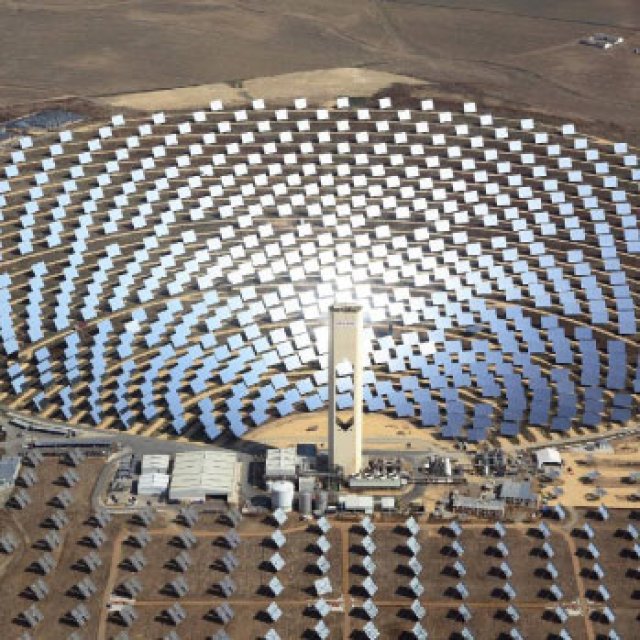
Right now, there is an opportunity to slash Australia’s carbon emissions by 5 million tonnes a year in one stroke. The city of Port Augusta in South Australia has all the right conditions to make it Australia’s first baseload renewable energy hub.
The two coal-fired power stations at Port Augusta are getting old. Industry experts say they may be forced to close as soon as 2015.
A new report by climate research group Beyond Zero Emissions (BZE) says all the conditions are right to replace the two plants with renewable energy.
The Port Augusta region has excellent sunlight and consistent, strong winds. These conditions make it well suited for a combination of solar thermal and wind power.
BZE says it will take six big solar plants, which use fields of mirrors to concentrate solar radiation in a central tower, to replace 60% of Port Augusta’s coal plant capacity.
State of the art big solar plants can store excess energy for use during cloudy periods or overnight. BZE says this means: “Electricity can thereby be dispatched as needed, to our homes, businesses and industry while the sun isn’t shining.”
Similar big solar plants are already operating or being built in Europe and the United States.
The remaining 40% can be met with 95 wind turbines. These advanced turbines, each with a capacity of 7.5 megawatts, are already operating in Europe.
Repowering Port Augusta with renewable energy is also the job-rich option. The report estimates it would create 360 permanent jobs in the city — more than replacing the 250 jobs connected to the two coal-fired power stations.
Building big solar and wind power would also create 1300 construction jobs over six years. It also makes sense to set up big solar manufacturing capacity in Port Augusta, which BZE says will add a further 225 ongoing jobs.
The other energy option for Port Augusta would be to replace the coal-fired plants with gas-fired plants. But gas-fired power is a job-killer.
A newly built 550 megawatt Mortlake gas-fired plant in Victoria employs just 10 permanent staff. If gas plants were used to replace Port Augusta’s 760 megawatts of coal power, it would be a disaster for local employment.
The gas option also comes with a host of environmental problems. Recent studies that measure emissions from gas over its entire “life cycle” — from extraction to burning — say it could be as bad for driving climate change as coal.
South Australia’s conventional gas reserves in the Cooper and Eromanga basins are running low. This means any gas-fired plants at Port Augusta would rely on unconventional gas, especially coal seam gas (CSG).
But the CSG industry is under fire from farmers and communities because of its big environmental costs. The fracking process needed to extract much of the gas will pollute the soil, air and water.
The CSG industry is also a huge water glutton. The federal government has estimated the industry will use about three times more water that Australian households use each year.
The BZE report also warns that gas-fired power locks in much higher power bills. As Australia begins to export gas to overseas markets, Australia’s domestic gas prices are expected to rise sharply.
Overseas gas prices are much higher than in Australia, giving gas companies little reason to sell gas in Australia for a lower price than they can get elsewhere.
The big gas companies are expected to link future gas prices to the volatile global oil price. BZE says this means that if gas-fired power was built at Port Augusta: “South Australia will begin to experience the same price volatility at the light switch that they now experience at the petrol pump.”
The BZE report gives several different funding options to repower Port Augusta with renewables. The federal government has already set aside a new $5 billion fund to finance renewable energy at low interest rates. BZE says this money could be enough to do the job.
Another option discussed in the report is a feed-in tariff, which levies consumers to guarantee a higher price for renewable electricity generators. BZE says such a feed-in tariff would add about 0.34% to power bills across the National Electricity Market. This rise, “is one 30th of the electricity price rises predicted to occur by the Australian Energy Market Commission out to 2013”.
BZE says the arguments for big solar and wind in Port Augusta stack up, but it needs state and federal government support to happen.
“This proposal outlines a pathway to energy security, power price stability, increased jobs, emissions reductions, and beneficial economic and health outcomes … It is a once in a generation opportunity that all South Australians, and all Australians, should support.”

Comments
Anonymous replied on Permalink